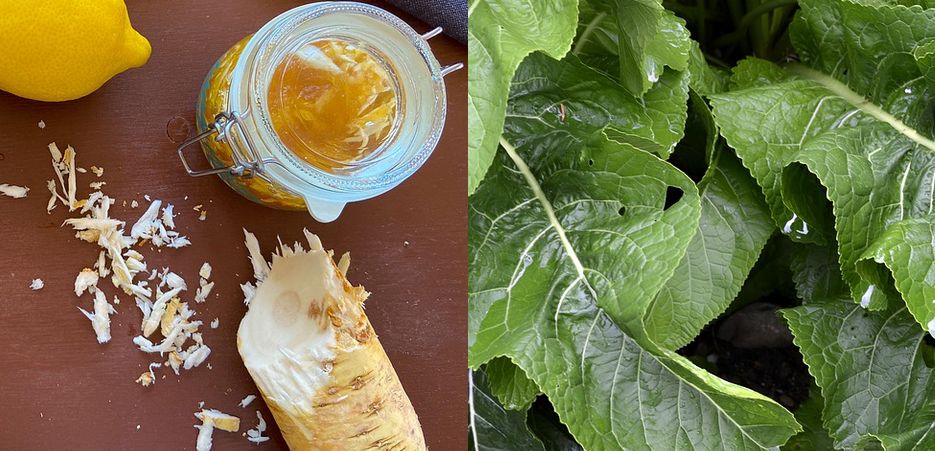Just remember, to retain pungency, you should not cook horseradish.
Nutrition
A very pungent root that controls bacterial infections and lowers fever, horseradish has a lot of flavor and no fat. One tablespoon of prepared horseradish contains 6 calories, 1.4 grams of carbohydrates, 14 milligrams of sodium, 44 milligrams of potassium, 9 milligrams of calcium, and 5 milligrams of phosphorous.
Forms
When buying fresh roots, choose the ones without blemishes and not sprouting. Generally speaking, the whiter the root, the fresher it is. Peel only what you are going to use and grate or shred in a food processor. Make sure your kitchen is well-ventilated as the pungent oils are volatile. Dehydrated granules, flakes, or powder are readily available; just add vinegar to power them up. Varieties of prepared horseradish include regular (grated horseradish with vinegar), cream style, and beet horseradish. Other products containing horseradish include mustard, cocktail sauce, other sauces, dips, spreads, relishes, and dressings.
Storage
The smaller roots store in the refrigerator in zip bags for up to two weeks or frozen for a couple of months. Grated or otherwise processed horseradish keep in the refrigerator. However the dried forms you should store in sealed glass containers in the spice cabinet.
Culinary Uses
Horseradish preparations are usually served cold because during cooking they lose so much pungency and flavor. Sauce or paste made of horseradish is often served with roast beef or cold meats like ham or corned beef. It is commonly served with fish in Europe; for example, in Norway they mix the grated root with whipped sweet and sour creams, vinegar and sugar to make a sauce called pepperotsaus that they serve it with cold, boiled fish such as salmon. The French mix it into cream sauces with lemon juice. Vinegar is commonly combined with it. Mixed with green food coloring, or powdered spinach as served as “wasabi.” In Austria, freshly grated horseradish mixing with grated sour apples and lemon juice. To make a relish for fried or roasted meat.
A good sauce for horseradish products is here.
To search for horseradish recipes, go here.
Other uses of horseradish include:
- Adding it, plus hot sauce, to tomato juice for a morning bracer.
- Or to bloody marys.
- Mixing it with mustard to increase the strength of the condiment.
- Adding it to scrambled eggs, omelets, and hash-browned potatoes.
- Grating a small amount into potato salad, coleslaw, or dips.
- Adding it to soups just before serving.
- Mixing it with prepared barbecue sauces.
- Mixing it with sour cream to add to mashed or baked potatoes.
- Sometimes you can add beet juice to grated horseradish to brighten the color.
- Adding it to tartar sauce, seafood cocktail sauces, hollandaise sauce, mayonnaise, and salad dressings.
- Making a horseradish butter with mustard and a little yogurt.
How to Prepare Fresh Horseradish
| Image sources |
|---|












